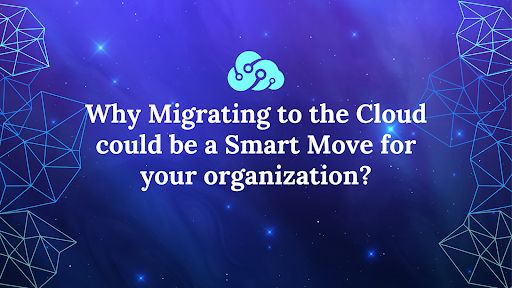Why Migrating
to Cloud in
2022 could be a Smart Move

Many organizations are looking to increase productivity and revenue. Are you one of them too?
If yes, Cloud Migration should be your next strategic move!
Cloud migration is the process of moving data, applications, and other business components from an on-premises environment to the cloud. The motivations for doing so are many and varied, but often include freeing up resources within the company, reducing IT costs, and increasing flexibility.
The process of migration can be complex, and there are a number of factors to consider before embarking on such a project. These include assessing which workloads are suited to the cloud, determining the right mix of public and private clouds, and ensuring that data is secure throughout the transition.
By carefully planning their migration strategy, businesses can ensure a smooth transition to this new way of working. With the help of experienced providers, they can take advantage of all that the cloud has to offer without compromising on security or performance.
Cloud Migration Strategies
There are five cloud migration strategies commonly known as 5Rs. Companies that want to migrate to the cloud should consider which migration strategy is right for them.
The 5 R’s are: re-host, re-platform, refactor, re-architect, and rebuild.
Re-hosting is the simplest and most common form of migration. It involves lifting and shifting an application from one environment to another with minimal changes. For example, moving an application from on-premises to the cloud. The main benefit of re-hosting is that it’s quick and easy to do. However, it’s important to note that this method doesn’t take advantage of the cloud’s full potential and can actually result in increased costs.
Re-platforming is the process of moving an application to a new host, which may also involve making changes to the application so it can run on the new platform. This can be done for a number of reasons, such as to improve performance, take advantage of new features or address security concerns.
Re-platforming can be a complex and costly undertaking, so it’s important to carefully consider whether it’s the best option for your needs. In some cases, it may be simpler and more cost-effective to simply re-host the application on a new platform. But in other cases, re-platforming can offer significant benefits that make it worth the effort.
Refactoring is the process of making changes to the application code so that it can run in a containerized environment. This includes making changes to the codebase, dependencies, and configuration. Refactoring can be done manually or with the help of automation tools.
Benefits of refactoring include improved performance, reduced memory footprint, and increased portability.
There are also some challenges associated with refactoring, such as ensuring that all tests still pass and that the application behaves as expected in its new environment. However, these challenges can be overcome with careful planning and testing.
Rearchitecting is a more drastic change where you redesign the application for the cloud.
Rearchitecting can be a complex and time-consuming process, but it offers several benefits over lift and shift. First, rearchitecting allows you to take advantage of cloud-native features that can improve performance and efficiency. Second, it gives you the opportunity to improve the security of your application by implementing new controls and best practices. Finally, rearchitecting can help you reduce costs by making use of cheaper resources or by eliminating unnecessary features.
Rebuilding an application from the ground up can be a daunting task, but it can also be a great opportunity to take a new approach to the design. This is where cloud migration comes in. By migrating your application to the cloud, you can take advantage of all the benefits that the cloud has to offer, including scalability, flexibility, and cost savings. The process of rebuilding an application in the cloud can be divided into three main phases: planning, execution, and monitoring.
Cloud Migration Processes
When it comes to cloud migration, there are a few key processes that need to be followed in order to ensure a successful transition.
First, it’s important to assess which workloads are best suited for the cloud. Not all applications can or should be migrated, so it’s critical to identify those that will benefit most from the move. Once you’ve determined which workloads will be moving to the cloud, the next step is to select a suitable provider. There are a number of factors that need to be considered when making this decision, such as cost, security, and performance.
Finally, once you’ve chosen a provider and migrated your workloads, it’s important to monitor and optimize them on an ongoing basis. By following these key steps, you can ensure a smooth and successful migration.
Why Migrate to the Cloud?
There are many reasons why an organization might choose to migrate to the cloud. Cloud migration can provide organizations with increased agility, scalability, and flexibility. Additionally, migrating to the cloud can help organizations save money on infrastructure and maintenance costs.
One of the biggest benefits of migrating to the cloud is increased agility. With the cloud, organizations can quickly deploy new applications and services without having to worry about provisioning or configuring new hardware. The cloud also makes it easy to scale applications and services up or down as needed, which can help organizations save money on resources that are not being used.
Another benefit of migrating to the cloud is improved disaster recovery capabilities. With the cloud, organizations can replicate their data and applications across multiple geographical locations for added protection against outages or disasters.
The Benefits of Cloud Migration
The cloud has become increasingly popular in recent years, as more and more businesses migrate to the cloud. There are many benefits to cloud migration, including increased flexibility, scalability, and cost savings.
The cloud is a highly flexible platform that can be easily scaled up or down to meet the changing needs of a business. This flexibility allows businesses to respond quickly to changes in demand and avoid over-provisioning or under-utilizing resources.
In addition, the pay-as-you-go model of cloud computing can provide significant cost savings for businesses. They no longer need to invest in expensive hardware and software upfront, and only pay for the resources they actually use.
Overall, the benefits of cloud migration can be huge for businesses of all sizes. By increasing flexibility, scalability, and reducing costs, the cloud can help businesses operate more efficiently and effectively.
How to get started with Cloud Migration
Despite the advantages of cloud computing, many businesses have been reluctant to migrate their data and applications to the cloud. The perceived risks and costs of migration can be daunting, but with the right planning and execution, migrating to the cloud can be a seamless process. Migrating to the cloud can seem like a daunting task, but with careful planning and execution it can be a relatively seamless process.
There are a few key things to keep in mind when planning a migration:
1. Define your goals and objectives. What do you hope to achieve by moving to the cloud? Is it improved scalability, reliability, or security? Once you know what your goals are, you can better determine which type of cloud platform is right for you.
2. Assess your current infrastructure. What type of data and applications do you need to move to the cloud? Do you have any legacy systems that need to be taken into account?
Not all workloads are suited for the cloud, so it’s important to make this determination upfront.
3. Create a detailed plan of action that takes into account all aspects of the migration, from data migration to application replatforming to changes in operational processes.
4. Work with a trusted partner who has experience in migrating workloads to the cloud. This will help ensure a smooth transition and minimize business disruptions.
How Sydata can help you with Cloud Migration
The cloud is becoming an increasingly popular option for businesses looking to reduce IT costs and improve efficiency. However, migrating to the cloud can be a daunting task. Sydata can help simplify the process and ensure a successful transition.
Sydata offers a comprehensive suite of tools and services to help businesses migrate to the cloud. Their experienced team will work with you to assess your needs and develop a custom plan for your transition. They can also provide ongoing support and guidance to ensure your success in the cloud.
Sydata’s cloud migration services can help you save time and money while reducing risk. Their experience and expertise can give you the peace of mind knowing that your transition will be successful.
Here are three ways that Sydata can help you make the transition:
1. We can help you assess your current infrastructure and determine which components can be moved to the cloud.
2. We can assist with the actual migration process, ensuring that your data is moved safely and securely.
3. We can provide ongoing support after the migration is complete, helping you to get the most out of your new cloud-based infrastructure.
Conclusion: Weighing the pros and cons of cloud migration
As organizations continue to face growing pressure to do more with less, many are turning to cloud migration as a way to improve efficiency and cut costs. But before making the move to the cloud, it’s important to weigh the pros and cons of such a transition.
There are also some potential risks associated with the migration such as security risks, data privacy concerns, vendor lock-in, and loss of control over data and applications.
On the plus side, migrating to the cloud can provide greater flexibility and scalability for businesses. It can also lead to increased agility and faster time-to-market for new products and services. In addition, cloud migration can help reduce IT infrastructure costs.
Given these considerations, it’s important for organizations to carefully weigh the pros and cons of cloud migration before making a decision.
